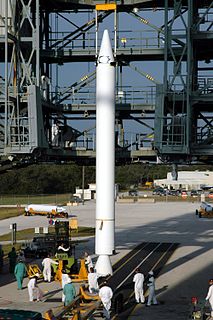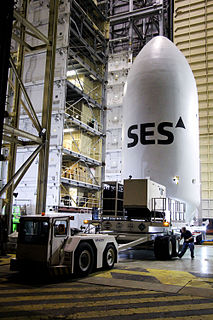Related Research Articles

A booster rocket is either the first stage of a multistage launch vehicle, or else a shorter-burning rocket used in parallel with longer-burning sustainer rockets to augment the space vehicle's takeoff thrust and payload capability. Boosters are traditionally necessary to launch spacecraft into low Earth orbit, and are especially important for a space vehicle to go beyond Earth orbit. The booster is dropped to fall back to Earth once its fuel is expended, a point known as booster engine cut-off (BECO).

Falcon 9 is a partially reusable two-stage-to-orbit medium-lift launch vehicle designed and manufactured by SpaceX in the United States. It is powered by SpaceX Merlin engines, burning cryogenic liquid oxygen and rocket-grade kerosene (RP-1) as propellants. Its name is derived from the fictional Star Wars spacecraft, the Millennium Falcon, and the nine Merlin engines of the rocket's first stage. The rocket evolved with versions v1.0 (2010–2013), v1.1 (2013–2016), v1.2 "Full Thrust" (2015–present), including the Block 5 Full Thrust variant, flying since May 2018. Unlike most rockets, which are expendable launch systems, since the introduction of the Full Thrust version, Falcon 9 is partially reusable, with the first stage capable of re-entering the atmosphere and landing vertically after separating from the second stage. This feat was achieved for the first time on flight 20 in December 2015.

Very large floating structures (VLFSs) or very large floating platforms (VLFPs) are artificial islands, which may be constructed to create floating airports, bridges, breakwaters, piers and docks, storage facilities, wind and solar power plants, for military purposes, to create industrial space, emergency bases, entertainment facilities, recreation parks, mobile offshore structures and even for habitation. Currently, several different concepts have been proposed for building floating cities or huge living complexes. Some units have been constructed and are presently in operation.
Vertical takeoff, vertical landing (VTVL) is a form of takeoff and landing for rockets. Multiple VTVL craft have flown. The most widely known and commercially successful VTVL rocket is SpaceX's Falcon 9 first stage.

Falcon 9 prototypes were experimental flight test reusable rockets that performed vertical takeoffs and landings. The project was privately funded by SpaceX, with no funds provided by any government until later on. Two prototypes were built, and both were launched from the ground.

The SpaceX reusable launch system development program is a privately funded program to develop a set of new technologies for an orbital launch system that may be reused many times in a manner similar to the reusability of aircraft. SpaceX has been developing the technologies over several years to facilitate full and rapid reusability of space launch vehicles. The project's long-term objectives include returning a launch vehicle first stage to the launch site in minutes and to return a second stage to the launch pad following orbital realignment with the launch site and atmospheric reentry in up to 24 hours. SpaceX's long term goal is that both stages of their orbital launch vehicle will be designed to allow reuse a few hours after return.

SpaceX CRS-8, also known as SpX-8, was a Commercial Resupply Service mission to the International Space Station (ISS) which was launched on April 8, 2016, at 20:43 UTC. It was the 23rd flight of a Falcon 9 rocket, the tenth flight of a Dragon cargo spacecraft and the eighth operational mission contracted to SpaceX by NASA under the Commercial Resupply Services program. The capsule carried over 3,100 kilograms (6,800 lb) of cargo to the ISS including the Bigelow Expandable Activity Module (BEAM), a prototype inflatable space habitat delivered in the vehicle's trunk, which will be attached to the station for two years of in-orbit viability tests.

SpaceX CRS-5, also known as SpX-5, was a Commercial Resupply Service mission to the International Space Station, conducted by SpaceX for NASA, and was launched on 10 January 2015 and ended on 11 February 2015. It was the seventh flight for SpaceX's uncrewed Dragon cargo spacecraft and the fifth SpaceX operational mission contracted to NASA under an ISS resupply services contract.

SpaceX CRS-6, also known as SpX-6, was a Commercial Resupply Service mission to the International Space Station, contracted to NASA. It was the eighth flight for SpaceX's uncrewed Dragon cargo spacecraft and the sixth SpaceX operational mission contracted to NASA under a Commercial Resupply Services contract. It was docked to the International Space Station from 17 April to 21 May 2015.

Falcon 9 v1.1 was the second version of SpaceX's Falcon 9 orbital launch vehicle. The rocket was developed in 2011–2013, made its maiden launch in September 2013, and its final flight in January 2016. The Falcon 9 rocket was fully designed, manufactured, and operated by SpaceX. Following the second Commercial Resupply Services (CRS) launch, the initial version Falcon 9 v1.0 was retired from use and replaced by the v1.1 version.

SpaceX CRS-7, also known as SpX-7, was a private American Commercial Resupply Service mission to the International Space Station, contracted to NASA, which launched and failed on June 28, 2015. It disintegrated 139 seconds into the flight after launch from Cape Canaveral, just before the first stage was to separate from the second stage. It was the ninth flight for SpaceX's uncrewed Dragon cargo spacecraft and the seventh SpaceX operational mission contracted to NASA under a Commercial Resupply Services contract. The vehicle launched on a Falcon 9 v1.1 launch vehicle. It was the nineteenth overall flight for the Falcon 9 and the fourteenth flight for the substantially upgraded Falcon 9 v1.1.

The Falcon 9 first-stage landing tests were a series of controlled-descent flight tests conducted by SpaceX between 2013 and 2016. Since 2017, the first stage of Falcon 9 missions has been routinely landed if the rocket performance allowed it, and if SpaceX chose to recover the stage.

An autonomous spaceport drone ship (ASDS) is an ocean-going vessel derived from a deck barge, outfitted with station-keeping engines and a large landing platform and is controlled by an autonomous robot. Construction of such ships was commissioned by aerospace company SpaceX to allow for recovery of rocket first-stages at sea for missions which do not carry enough fuel to return to the launch site after boosting spacecraft onto an orbital or transplanetary trajectory.

SES-9 is a geostationary communications satellite operated by SES S.A. It was launched from Cape Canaveral SLC-40 by a Falcon 9 Full Thrust rocket on 4 March 2016.

Falcon 9 Full Thrust is a partially reusable medium-lift launch vehicle, designed and manufactured by SpaceX. Designed in 2014–2015, Falcon 9 Full Thrust began launch operations in December 2015. As of 6 October 2020, Falcon 9 Full Thrust had performed 74 launches.

Landing Zone 1 and Landing Zone 2, also known as LZ-1 and LZ-2 respectively, are landing facilities for recovering components of SpaceX's VTVL reusable launch vehicles. LZ-1 and LZ-2 were built on land leased in February 2015 from the United States Air Force, on the site of the former Cape Canaveral Launch Complex 13. SpaceX built Landing Zone 2 at the facility to have a second landing pad, allowing two Falcon Heavy boosters to land simultaneously.

Ms. Tree, formerly known as Mr. Steven, and its sister ship, Ms. Chief are marine vessels chartered by SpaceX as platforms for recovery of rocket payload fairings. These ships have been retrofitted with large nets that are intended to catch fairings—to prevent the fairings from making contact with seawater—as a part of an iterative development program to create technology that will eventually allow rocket payload fairings to be economically reused and reflown.
Blue Origin landing platform ship is a roll-on/roll-off cargo ship owned by rocket and space technology company Blue Origin, purchased in 2018 for use as a floating landing platform for its New Glenn booster stage. As of late 2018, the ship is undergoing refit to prepare for its role of landing rockets.

Falcon 9 B1046 was a reusable Falcon 9 first-stage booster manufactured by SpaceX. It flew four times between 2018 and 2020 before breaking up during a successful abort test of the Crew Dragon. It was the first Block 5 upgrade to the Falcon 9.
References
- ↑ "SpaceX Announces Spaceport Barge Positioned by Thrustmaster's Thrusters". Thrustmaster. 22 November 2014. Archived from the original on 7 December 2014. Retrieved 23 November 2014.
- ↑ Bergin, Chris (17 December 2014). "SpaceX confirms CRS-5 launch slip to 6 January". NASASpaceFlight.com. Retrieved 18 December 2014.
- ↑ Foust, Jeff (25 October 2014). "Next Falcon 9 Launch Could See First-stage Platform Landing". Space News. Retrieved 25 October 2014.
- ↑ Bullis, Kevin (25 October 2014). "SpaceX Plans to Start Reusing Rockets Next Year". MIT Technology Review. Retrieved 26 October 2014.
- ↑ Dean, James (24 October 2014). "SpaceX to attempt Falcon 9 booster landing on floating platform" . Retrieved 27 October 2014.
- ↑ Musk, Elon (22 November 2014). "Autonomous spaceport drone ship". SpaceX. Retrieved 23 November 2014.
- ↑ "SpaceX Rocket Makes Spectacular Landing on Drone Ship". Phenomena. Retrieved 10 April 2016.
- ↑ SpaceX to attempt five recoveries in less than two weeks as fleet activity ramps up, NASAspaceflight.com, 19 July 2018, accessed 2 August 2018.
- ↑ Burghardt, Thomas (20 September 2018). "Building on New Shepard, Blue Origin to pump a billion dollars into New Glenn readiness". NASASpaceFlight.com . Retrieved 22 September 2018.
- ↑ Jeff Bezos' Blue Origin ship to be used for rocket landings docked at Port of Pensacola, Pensacola News Journal, 24 October 2018, accessed 4 November 2018.